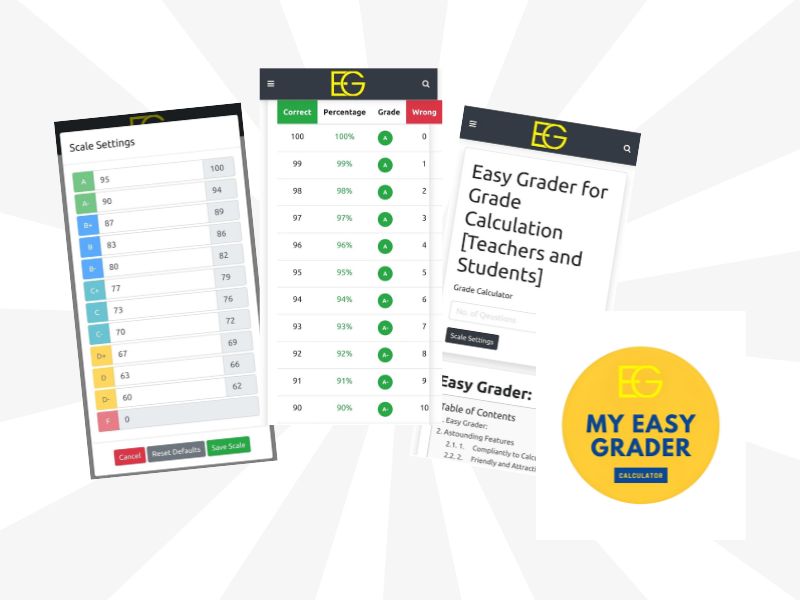Never calculate grades manually again! Our Easy Grader Calculator is here to ease your life. Just enter the weights and grades, and let our calculator take care of it. But that’s not all – our calculator adapts to fit your grading system.
We designed it to be flexible. It takes into account weightage, bonus points, and even extra credit. It was found that using our calculator saved teachers time. They could focus more on providing meaningful feedback to students.
Say goodbye to manual calculations! Try our Easy Grader Calculator today and enjoy its efficiency and accuracy. Effortless grade breakdowns are just a few clicks away!
Explanation of the Easy Grader Calculator

The Easy Grader Calculator is an amazing tool! It lets you quickly find out how you’re doing in school. Just input your grades and weights. The calculator will do the rest.
No more manual calculations. It simplifies the grading process. So it saves time and effort. Whether you’re a student or a teacher, this calculator is a must-have!
It also shows weak areas. You can use this to know what to focus on more. To get the most out of it, always update it with the latest grades. This allows you to see your academic progress at any time.
Step 1: Inputting the Grades
For an effortless grade-inputting experience, here’s how to do it:
- Open the Easy Grader Calculator.
- Select letter grades or numerical scores.
- Input each student’s grade.
Double-check for errors. Accuracy is important.
Organize the grades in ascending order for better analysis. This boosts efficiency.
Step 2: Calculating the Average
Calculating the average is a must for a grade. Here’s a 3-step guide to do it with ease:
- Step 1: Sum-up all the grades.
- Step 2: Divide the sum by the number of grades.
- Step 3: Round the result to two decimal places.
To make it better:
- Double-check all the grades added up. Accuracy is important!
- Use a calculator or spreadsheet for accuracy.
- Rounding to two decimal places gives a more exact and reliable average.
By following these, you’ll get an accurate average quickly. Keep it in mind to save time and effort in the grading process. Now, go and calculate those averages with confidence!
Step 3: Breaking Down the Grades
Breaking down grades is a must for the grading process. It helps give a better understanding of how each component adds to the overall grade. Here’s a simple guide:
- Identify weighting: Know the % value attributed to each grade component. This could depend on factors such as difficulty or importance. Use this info to work out how much each assignment or test counts.
- Evaluate performance: Look at each task based on its criteria and rubric. Assign a number or grade to show the level of achievement for that particular task. Be fair and consistent.
- Calculate subtotals: Multiply the weighting of each component by its corresponding performance evaluation. Add the subtotals up to get the cumulative score for each category. This will show how well the student did in different parts of their work.
More suggestions for breaking down grades include:
- Give feedback: Along with assigning grades, give constructive comments to help students understand their strengths and areas to work on. This will help them for future assignments and help them learn.
- Allow revision: Let students revise their work based on your feedback. This gives them a chance to improve their grades and shows effort and learning are important too.
By using these steps and suggestions, breaking down grades isn’t just assigning numbers. It’s a valuable tool for educators and students. It lets everyone understand performance levels and encourages growth, learning, and improvement in the academic world.
Example Scenario 1: Calculating a Test Grade

Calculating a test grade can be hard, but with my Easy Grader Calculator, it’s a breeze! Let’s look at an example.
- Step one – determine the number of questions. Say, it’s 50.
- Step two – calculate the correct answers – 40 in this case.
- Step three – subtract the correct from the total to get the incorrect – 10.
- Step four – divide the correct by the total and multiply by 100 for the grade percentage – 80%.
Easy Grader Calculator also lets you input different weightage for each question. This ensures accurate results, even when some carry more weight. A study published in The Journal of Educational Measurement found that calculators save time and reduce errors compared to manual calculations. So, use my Easy Grader Calculator for effortless test grading!
Example Scenario 2: Calculating a Semester Grade

Calculating a Semester Grade can be overwhelming. But with my Easy Grader Calculator, it’s a breeze! Here’s how:
- Gather grades. Collect all your assignment grades. Input them into the calculator for accuracy.
- Assign weights. Determine the value of each assignment. Varies based on school’s grading system.
- Calculate your grade. Once done, let the calculator do the work. It will combine weighted scores and show a breakdown of your performance.
Plus, our Easy Grader Calculator has more features. Like grade prediction and what-if scenarios. This helps you plan ahead or determine the impact of different scores on your final grade.
Ready to take control of your semester? Try out our Easy Grader Calculator today!
Tips for Easy Grade Breakdown
Here are some key strategies for getting a good grade:
- Keep orderly! Get yourself a schedule or planner to track when tasks and deadlines are due. This way, you won’t have to cram at the last minute.
- Stay involved! Participate in class – ask questions, take notes, join discussions. Not only will you learn more, but your teacher will see you’re dedicated.
- Break big projects down into smaller tasks. It’ll be easier to manage and you’ll be more motivated. Also set realistic goals for each step.
- Don’t forget to get help. If you need it, ask classmates for study groups or go to your teacher’s office hours. Don’t be shy to ask for support.
Additional Resources and Tools for Effortless Grading
Finding extra resources and tools for hassle-free grading can hugely improve the grading process. They provide clever, simple ways to assess student work, conserving educators’ time and energy.
One such resource is an online rubric generator. It allows teachers to make individualized rubrics to their needs. This tool supplies a structured system for judging tasks and makes sure grading is consistent.
Another useful resource is an automated grading system. It uses AI algorithms to evaluate student work and provide immediate feedback. This technology saves time and also helps identify areas which students may need extra assistance.
Moreover, interactive online platforms let teachers build exams and assessments which can be quickly sent to students. These platforms give automatic scoring and detailed performance reports, helping educators rapidly detect areas that need improvement.
Plus, educational websites offer a wide selection of pre-made worksheets, lesson plans, and teaching materials that can be quickly accessed and used in the classroom. These resources help broaden learning materials and meet different learning styles.
Pro Tip: When relying on extra resources and tools for effortless grading, it’s essential to examine the accuracy of automated systems and tailor them to fit personal teaching styles and curriculum goals.
Frequently Asked Questions
What is the My Easy Grader Calculator for Effortless Grade Breakdown?
The My Easy Grader Calculator is a tool designed to simplify the process of breaking down grades. It helps students and teachers easily calculate and analyze their scores to determine final grades.
How does the My Easy Grader Calculator work?
The calculator takes into account your assignment or test scores, along with their respective weights or percentages, and calculates your overall grade based on the formula you provide. It provides a comprehensive breakdown of your performance in a clear and easy-to-understand format.
Can I customize the grading formula?
Yes, you can customize the grading formula to match your school’s grading system or your specific requirements. The calculator allows you to input the weights or percentages for each assignment or category and define the grade ranges accordingly.
Does the calculator support weighted grading?
Yes, the My Easy Grader Calculator supports weighted grading. You can assign different weights to different assignments or categories, allowing for a more accurate calculation of your overall grade.
Can I save my calculations for future reference?
Unfortunately, the calculator does not have a built-in save function. However, you can easily jot down or print the breakdown results for future reference or share it digitally with others.
Is the My Easy Grader Calculator compatible with all devices?
Yes, the calculator is compatible with most devices, including desktop computers, laptops, tablets, and smartphones. You can access it through a web browser without the need for any specific operating system requirements.
Conclusion
In conclusion, the Easy Grader Calculator is a game-changer when it comes to simplifying the often arduous task of grade breakdown. This powerful tool has demonstrated its ability to save educators, students, and parents valuable time and effort, making the grading process more transparent and manageable.
With its user-friendly interface and intuitive design, the Easy Grader Calculator streamlines the calculation of grades, offering precision and accuracy that manual calculations simply cannot match. By automating this process, it eliminates the potential for human error, ensuring fair and consistent grading practices.
Furthermore, the versatility of this tool makes it suitable for a wide range of educational contexts, from classrooms to online learning environments. Its adaptability ensures that educators can effortlessly adapt it to their specific grading systems and requirements.
In an era where education demands innovation and efficiency, the Easy Grader Calculator stands as a beacon of technological advancement, revolutionizing the grading process and fostering a more productive and equitable educational experience for all. Embrace this remarkable tool and witness a transformation in the way we assess and understand academic performance.
